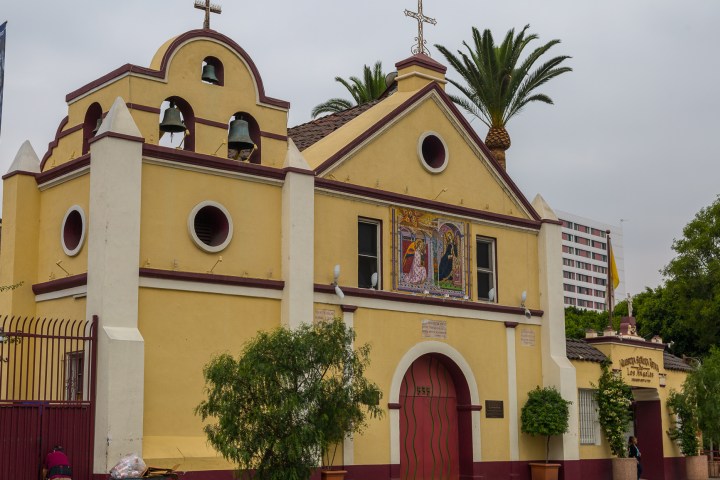
In downtown Los Angeles, not far from the towering skyscrapers and iconic city administration building is a small, out of the way pocket of Old Mexico known as Olivera Street. If you’re running short of curios for your next Cinco de Mayo party or just need to stock up on Día de Muertos costumes, you need to head to Olivera Street. It’s also a wonderful excursion and opportunity to learn about the history of this behemoth city on the West Coast.
Los Angeles was founded in 1781 on the Los Angeles River, a short distance from Olivera Street, by a dozen or so settlers, a priest, and a few soldiers to keep an eye on the Tongva native Americans who had a village nearby. The little hamlet was given an imposing name: El Pueblo de Nuestra Señora Reina de los Ángeles (The Town of the Queen of the Angels). Soon they’d built a church, started planting fields, and began filming the first Western movie about the conflict between cattle ranchers and sheep herders. (Actually, Hollywood was still a few years off…this is a Kongo exaggeration.)

The downtown area shifted slightly south in the late 19th century and the pueblo area declined. A number of ethnic ghettos formed — Chinatown, Japantown, Philipinotown, and so forth. City leaders were ready to raze the entire area in the 1920s but the Los Angeles Historical Society shamed the city fathers enough that they kept it. Today Olivera Street and the surrounding area is part of a State Park that preserves some of the oldest remaining structures in Los Angeles and a houses park over the boundaries of the original pueblo.

The Avila House, the oldest residence in Los Angeles (admission is free), is part of the historic preservation around Olivera Street. It dates from 1818.

You have to look hard for it, underneath Mexican blankets, leather sandals, and sombreros, but you can still find traces of Old Los Angeles. It’s a hard look and most visitors jump off their tour bus race up and down the stalls, pick a T-shirt or Mexican bullwhip, and head off to Homes of the Stars. But if you squint your eyes and peer under the old pepper trees and bougainvillea you can almost see it.


There are lots of little shops to get your Heche en Mexico fix and a number of restaurants that serve up rolled tacos and enchiladas. And then there’s the Day of the Dead stuff. On October 31, the gates of heaven are opened and for 24-hours the living have a chance to commune with their beloved family members who have gone on to a better world. Naturally this is a big deal and there is a lot of cooking delicacies and preparing costumes to make the dear departed feel at home.



These ceramic skulls symbolize the more traditional sugar or chocolate skulls that artisan bakers make to welcome their visiting loved ones at Day of the Dead time.


If skulls aren’t your thing there are plenty of little Mexican dresses for the granddaughter in Iowa or a colorful shawl to keep you warm. And Dad can surely use one of these woven straw cowboy hats.
But wait, there’s more!
Next to Olivera Street is a statue of Antonio Aguilar, the Mexican Cowboy. Aguilar was a movie star and singer. He has his own star on the Hollywood Walk and was the only Hispanic performer to sell out Madison Square Garden for six nights in a row. He died in 2007 and is buried on the family ranch in Mexico. Kongo recommends that you watch the video below to get in the mood before visiting Olivera Street.

Across the street from Antonio is the art deco styled Union Station. If you like this kind of architecture as much as Kongo you should take a few minutes to stroll through the building and imagine yourself back in the 1930s when starlets would come off the train and head for Hollywood and Vine to get discovered.

There’s a fire station from the 1890s and some museums about Hispanic art in Los Angeles during the first half of the 20th century. The Pico House was once the fanciest hotel in Southern California and boasted 30 suites and indoor plumbing in the mid-1800s.

The next time you’re thinking of what you might do while waiting for traffic to clear in LA, take the Los Angeles Street exit off the 101 and spend a few hours on Olivera Street!

Travel safe. Have fun.



Beautiful! I enjoy the old feel of the place.
Well, that’s artistic license…it is a bit contrived actually. So glad you survived Matthew!
This brings back very nice memories of our trip to LA in 2011…we had spent quite a bit of time walking around old LA and it was very interesting. Nice pics. (Suzanne)
👍🏼